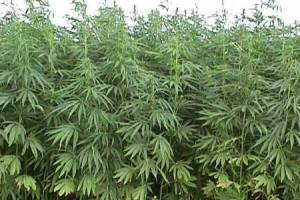Truth Seeker
New Member
Here's a riddle, what's been illegal to grow for decades until Amendment 64 made it legal in Colorado? It has tens of thousands of uses, but getting high isn't one of them. The answer: hemp.
Now for the first time since World War II a crop of industrial hemp is growing in the far Southeastern corner of Colorado.
Ryan Loflin planted his name in history when he first transplanted a small patch of hemp on the farm he grew up on outside Springfield.
"I always thought I'd be the pioneer of leaving farming," Loflin said.
On the same land his grandfather and father have grown corn, wheat and alfalfa hay, Loflin is coming back home because he sees hemp as the future of Colorado farming.
"This is the future because it's got so many uses. This crop will be used in so many different industries that it's not going to be limited to either food or fuel," Loflin said.
Analysts estimate already the market in the United States for hemp products that include food, beauty supplies and clothing is in the hundreds of millions of dollars, but all of the hemp is imported, mostly from Canada, China and Central America.
"You can make anything but glass out of hemp," Loflin said.
Grown for generations in the United States, hemps' fortunes went down in the 1930's as it was lumped in with its close cousin marijuana.
During World War II it enjoyed a brief revival as the federal government released a propaganda film titled "Hemp for Victory," encouraging farmers to grow the plant to help supply rope for the Navy, and parachutes for the Army.
In 1970 the U.S. Congress designated hemp, along with marijuana, as a "Schedule 1" drug under the Controlled Substances Act, making it illegal to grow without a license from the U.S. Drug Enforcement Administration.
But advocates and research shows industrial hemp doesn't have enough THC, the psychoactive ingredients to make a smoker "high."
"Marijuana has anywhere from 15-25% and this has 0.3% so there is no psychoactive benefits at all," Loflin said.
Loflin and a partner are planning on growing around 70 acres this summer. Different strains from Asia and Europe are being tested to see which will thrive in this climate. Without an industrial infrastructure in place to process the hemp into thousands of different products, the hemp grown on the Loflin farm will be harvested for seed.
Just like his family has done since the 1930's, Loflin hopes what's grown on this land will provide for his own family.
"I hope to leave them a hempire, basically," Loflin said.

News Hawk- Truth Seeker 420 MAGAZINE ®
Source: krdo.com
Author: Jonathan Petramala
Contact: KRDO Station Information - Colorado Springs, Pueblo - KRDO.com
Website: A 'hempire' growing in Springfield | News - Home
Now for the first time since World War II a crop of industrial hemp is growing in the far Southeastern corner of Colorado.
Ryan Loflin planted his name in history when he first transplanted a small patch of hemp on the farm he grew up on outside Springfield.
"I always thought I'd be the pioneer of leaving farming," Loflin said.
On the same land his grandfather and father have grown corn, wheat and alfalfa hay, Loflin is coming back home because he sees hemp as the future of Colorado farming.
"This is the future because it's got so many uses. This crop will be used in so many different industries that it's not going to be limited to either food or fuel," Loflin said.
Analysts estimate already the market in the United States for hemp products that include food, beauty supplies and clothing is in the hundreds of millions of dollars, but all of the hemp is imported, mostly from Canada, China and Central America.
"You can make anything but glass out of hemp," Loflin said.
Grown for generations in the United States, hemps' fortunes went down in the 1930's as it was lumped in with its close cousin marijuana.
During World War II it enjoyed a brief revival as the federal government released a propaganda film titled "Hemp for Victory," encouraging farmers to grow the plant to help supply rope for the Navy, and parachutes for the Army.
In 1970 the U.S. Congress designated hemp, along with marijuana, as a "Schedule 1" drug under the Controlled Substances Act, making it illegal to grow without a license from the U.S. Drug Enforcement Administration.
But advocates and research shows industrial hemp doesn't have enough THC, the psychoactive ingredients to make a smoker "high."
"Marijuana has anywhere from 15-25% and this has 0.3% so there is no psychoactive benefits at all," Loflin said.
Loflin and a partner are planning on growing around 70 acres this summer. Different strains from Asia and Europe are being tested to see which will thrive in this climate. Without an industrial infrastructure in place to process the hemp into thousands of different products, the hemp grown on the Loflin farm will be harvested for seed.
Just like his family has done since the 1930's, Loflin hopes what's grown on this land will provide for his own family.
"I hope to leave them a hempire, basically," Loflin said.

News Hawk- Truth Seeker 420 MAGAZINE ®
Source: krdo.com
Author: Jonathan Petramala
Contact: KRDO Station Information - Colorado Springs, Pueblo - KRDO.com
Website: A 'hempire' growing in Springfield | News - Home


